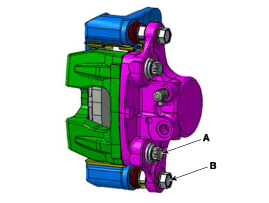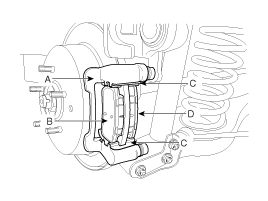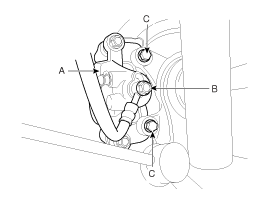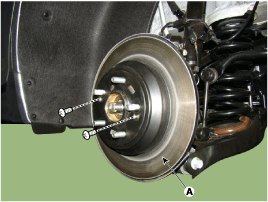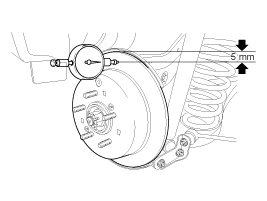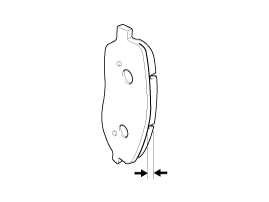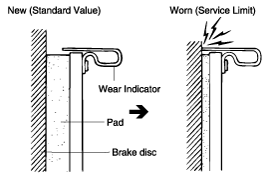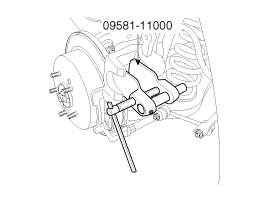Hyundai Genesis: Brake System / Rear Disc Brake Repair procedures
Hyundai Genesis (DH) 2013-2016 Service Manual / Brake System / Brake System / Rear Disc Brake Repair procedures
| Removal |
| 1. |
Remove the rear wheel & tire.
|
| 2. |
Loosen the guide rod bolt (B) and pivot the caliper up out of the way.
|
| 3. |
Remove pad shim (B), pad retainers (C) and brake pads (B) in the caliper bracket (A).
|
| 4. |
Loosen the hose eyebolt (B) and caliper mounting bolts (C), then remove the rear caliper assembly (A).
|
| 5. |
Remove the rear brake disc (A) by loosening the screws.
|
| Replacement |
| 1. |
Loosen the guide rod bolt (B) and pivot the caliper up out of the way.
|
| 2. |
Replace pad shim (B), pad retainers (C) and brake pads (B) in the caliper bracket (A).
|
| Inspection |
Rear Brake Disc Thickness Check
| 1. |
Check the brake pads for wear and fade. |
| 2. |
Check the brake disc for damage and cracks. |
| 3. |
Remove all rust and contaminating materials from the surface,
and measure the disc thickness at the place of 5mm from the outer
circumference as the illustration below.
If wear exceeds the limit, replace the discs and pad assembly on the left and right of the vehicle. |
Rear Brake Pad Check
| 1. |
Check the pad wear. Measure the pad thickness and replace it, if it is less than the specified value.
|
| 2. |
Check that grease is applied to sliding contact points, and check the pad and backing metal for damage.
|
Rear Brake Disc Runout Check
| 1. |
Place a dial gauge about 5mm (0.2 in.) from the outer circumference of the brake disc, and measure the runout of the disc.
|
| 2. |
If the runout of the brake disc exceeds the limit specification, replace the disc, and then measure the runout again. |
| 3. |
If the runout exceeds the limit specification, install the
brake disc after turning it 180° and then check the runout of the brake
disc again. |
| 4. |
If the runout cannot be corrected by changing the position of the brake disc, replace the brake disc. |
| Installation |
| 1. |
To install, reverse the removal procedure. |
| 2. |
Use a SST (09581-11000) when installing the brake caliper assembly.
|
| 3. |
After installation, bleed the brake system.
(Refer to Brake System - "Brake System Bleeding") |
 Rear Disc Brake Components and Components Location
Rear Disc Brake Components and Components Location
Components
1. Guide rod bolt2. Bleed screw3. Caliper body4. Caliper carrier5. Inner pad shim6. Brake pad7. Pad retainer
...
 Stop Lamp Switch Components and Components Location
Stop Lamp Switch Components and Components Location
Components Location
1. Brake pedal member assembly2. Stop lamp switch3. Clevis pin4. Snap pin5. Brake pedal stopper6. Return spring7. Bolt
...
Other information:
Hyundai Genesis (DH) 2013-2016 Service Manual: Engine Control Module (ECM) Repair procedures
Removal For the vehicle equipped with the immobilizer, the procedures shown below must be performed after replacing the ECM. [In the case of installing used ECM] 1) Perform "ECM Neutral mode" procedure with GDS. (Refer to "Immobilizer" in BE group) 2) After finishing ...
Hyundai Genesis (DH) 2013-2016 Service Manual: Assist Handle Repair procedures
Replacement • Put on gloves to protect your hands. • When removing with a flat-tip screwdriver or remover, wrap protective tape around the tools to prevent damage to components. • When removing the interior trim pieces, use a pla ...
© 2013-2025 www.hgenesisdh.com

